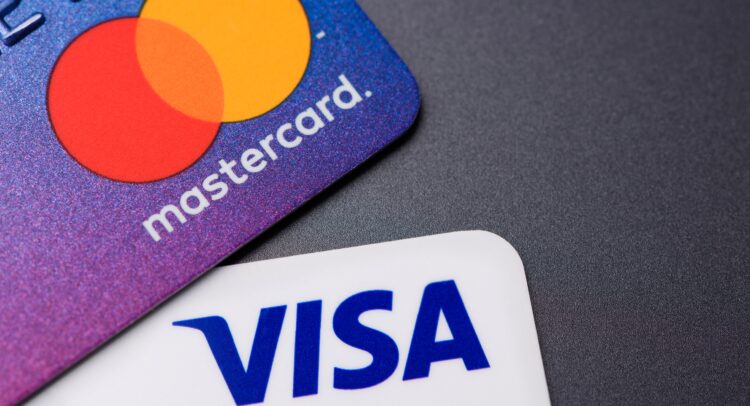The earnings season has arrived, and credit card giants Visa (V) and Mastercard (MA) are set to report their September quarter results on October 29 and 31, respectively. In this article, I will use the TipRanks Stock Comparison Tool to explain why, despite my bullish stance on both stocks, I believe Mastercard has a slight advantage heading into earnings day, making it the better buy.
Don't Miss our Black Friday Offers:
- Unlock your investing potential with TipRanks Premium - Now At 40% OFF!
- Make smarter investments with weekly expert stock picks from the Smart Investor Newsletter

Visa’s Fiscal Q3 Recap
Despite Visa’s underwhelming Q3 results reported in July, my long-term bullish thesis remains intact, even though the report raised some cautionary flags. Visa delivered an EPS of $2.42, which met estimates. However, the company reported revenue of $8.9 billion, slightly missing analysts’ expectations of $8.924 billion. Still, this figure represents a 9.6% increase from the $8.12 billion reported a year earlier.

Growth was fueled by an increase in cards in circulation, rising from 4.1 billion to 4.5 billion, which boosted transactions and transaction volume. Visa processed 59.32 billion transactions during Q3, a 9.8% increase from 54.03 billion in the same period last year, resulting in a payments volume of $3.78 trillion for the quarter.
Despite initial market pessimism following Visa’s Q3 earnings call, the stock has risen by around 12% since then. This performance came despite three Wall Street analysts lowering their price targets, offset by one upgrade and two price target increases.
How Fiscal Q4 Is Shaping Up for Visa
One of my concerns about adopting an ultra-bullish stance ahead of Visa’s earnings is the potential for Q4 to be weaker than anticipated. In its earnings call, Visa’s management indicated that the outlook for upcoming quarters, including Q4, could be slightly softer due to external factors such as a hurricane affecting parts of Texas, a cyber outage from CrowdStrike (CRWD), and various macroeconomic pressures.
Management also stated that Q4 non-GAAP revenue should grow at a low double-digit rate, with a 10% growth translating to approximately $9.47 billion. Wall Street’s consensus is slightly higher at $9.48 billion, reflecting 10.25% growth, despite 19 of 21 analysts revising estimates downward in the past three months. For EPS, Visa guided for high single-digit growth, with analysts expecting $2.58, implying 10.8% annual growth.

Beyond topping analyst’s expectations, a key focus for Visa’s upcoming earnings will be its progress in “value-added services” (VAS), a significant growth driver. In Q3, Visa generated $2.2 billion from VAS, a 23% increase, positioning the company to exceed $8 billion in VAS revenue this year. This reflects Visa’s efforts to diversify its revenue streams beyond traditional swipe fees and progress in this area is likely to positively influence the stock price’s reaction.
Is V a Buy, According to Wall Street Analysts?
Looking at Wall Street consensus, 23 out of 28 bullish analysts rate Visa Stock a Strong Buy, with an average price target of $314.09 implying a potential upside of 10.29%.


See more V stock analyst ratings
Mastercard’s Q2 Recap
Shifting focus to Mastercard, the second-largest credit card company globally, I hold a slightly more bullish stance on the stock ahead of its earnings. Mastercard has performed well in 2024, with shares up 21%. The company’s recent quarters indicate that it is benefiting from a resilient global economic environment, which is driving steady earnings growth.
In Q2, Mastercard reported revenues of $7 billion, marking an 11% year-over-year increase, which exceeded the $6.85 billion consensus. The company also posted adjusted diluted EPS of $3.59, a 24% year-over-year increase, surpassing the consensus estimate of $3.51. However, the most notable shortcoming in the report was purchase volume, which totaled $1.97 trillion, slightly below the consensus estimate of $2.01 trillion.

What likely fueled the 17% rally in Mastercard’s shares after its Q2 results was CEO Michael Miebach’s statement that double-digit top and bottom-line growth was driven by “continued healthy consumer spending.” This was in contrast to Visa’s management, which highlighted a slight moderation in spending within the lower consumer segment in the U.S. Consequently, seven Wall Street firms raised their target prices for Mastercard, with only one reducing their estimate.
How Q3 Is Shaping Up for Mastercard
While I’m leaning more bullish on Mastercard ahead of its earnings, it’s important to note that growth expectations for the September quarter are quite similar to Visa’s. Mastercard’s Q3 guidance anticipates low double-digit growth in non-GAAP revenues, with Wall Street projecting $7.26 billion—an 11.2% year-over-year increase. The company also expects operating expenses to rise by low double digits, aligning with consensus estimates of Q3 EPS at $3.74, reflecting a 10.5% year-over-year increase.

Although the bar for top-line estimates is relatively high, with 17 out of 19 analysts raising their projections in the last three months, I believe there is minimal risk of Mastercard missing revenue expectations—something it hasn’t done since Q3 2020—unlike Visa, which missed last quarter.
Moreover, the recent Fed rate cut has likely supported both Mastercard and Visa shares by boosting card usage activity, which may be better reflected in Q3 results. Another significant factor that could drive Mastercard’s stock higher is its international performance, with gross dollar volume (GDV) growing 9% year-over-year in Q2, compared to 6% growth in the U.S. This outpaced Visa’s 5% growth in both the U.S. and internationally, potentially explaining Mastercard’s outperformance relative to Visa throughout the year.
Is MA a Buy, According to Wall Street Analysts?
The Wall Street consensus on Mastercard is highly favorable, with 22 out of 26 analysts recommending a Buy, giving it a Strong Buy rating. The average price target of $537.54 implies a potential upside of 4.78%.


Key Takeaway
While I have a long-term bullish outlook for both Visa and Mastercard, if I had to choose one as the better buy ahead of its earnings, I would lean toward Mastercard. Although this is a close call, I believe Mastercard has a stronger chance of exceeding estimates, given its recent earnings performance and the more confident narrative from its management regarding growth expectations amid macroeconomic challenges and on the international front.



















